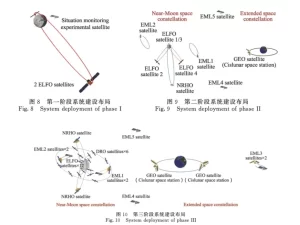Chinese scientists have proposed a comprehensive plan to build infrastructure between Earth and the moon, aiming to meet national strategic needs and enhance the safety and ease of space travel.
This ambitious project, detailed by researchers from the China Academy of Space Technology (CAST) and the Beijing Institute of Spacecraft System Engineering, includes a network of 30 satellites and three lunar ground stations. The infrastructure aims to provide real-time communication, navigation, and monitoring services to global users.
The proposed network will enable over 20 travelers to simultaneously communicate with Earth through images, audio, or video. It will also offer precise positioning, navigation, and timing (PNT) during Earth-moon flights and lunar surface operations. Additionally, the system will monitor and track moving targets as small as one meter (3.28 feet) within cislunar space, the region between Earth and the moon.
Strategic Importance of Cislunar Space
“Cislunar space has become a new frontier for human activities,” wrote the team led by Yang Mengfei, chief designer of China’s Chang’e-5 mission. The rapid expansion of space activities in this region is driving a new wave of global competition for resources such as orbital slots and radio frequencies. This urgency highlights the need for China to establish a top-level roadmap for developing cislunar space infrastructure and gaining a competitive edge in the emerging cislunar economy.
The United States Air Force is developing the Cislunar Highway Patrol System to demonstrate capabilities in detecting, tracking, and identifying artificial objects at lunar distances, significantly beyond traditional geostationary detection ranges. Meanwhile, civil space agencies in the US, Europe, and Japan have proposed similar infrastructures to support scientific exploration and commercial operations on the moon.
As China emerges as a significant player in lunar and deep space exploration, strategic planning is crucial to avoid repetitive construction and optimize resource allocation. This planning includes crewed lunar landings, the construction of an international lunar research station, and exploration missions to the outer solar system. The researchers noted that while plans exist in other countries, none have been implemented yet, giving China a unique opportunity to secure a substantial share in the emerging cislunar space industry.

Stages of Infrastructure Development
China’s cislunar infrastructure development will unfold in three stages:
- First Stage: Focus on supporting robotic and crewed moon missions with a pair of satellites in elliptical lunar orbits and a control station on the lunar surface, enabling communication for at least 10 users simultaneously.
- Second Stage: Expand the system to include 10 satellites orbiting the moon, Earth, and specific Earth-moon Lagrange points, with a second lunar ground station improving data transmission rates to 5 gigabytes per second and navigation accuracy to 100 meters for the lunar south pole region.
- Third Stage: Integrate a comprehensive network of 30 satellites, three lunar ground stations, and existing Earth-based communication and navigation facilities, achieving data transmission rates of 10 gigabytes per second and improved navigation accuracies to 10 meters for lunar surface activities and 50 meters for Earth-moon journeys.
The proposed network will also deploy a Very Long Baseline Interferometry system to track spacecraft across distances up to 900 million kilometers (559 million miles) with sub-kilometer accuracy, supporting deep space missions to Jupiter and beyond.

The researchers emphasized that the development of cislunar infrastructure must follow principles of phased development and dynamic expansion. It should also consider the needs for international compatibility and cooperation to support China’s aspirations as a space power and nurture new aerospace industries in the country.


















